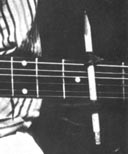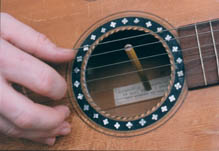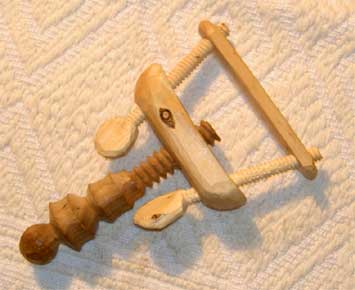| Poor Boy Capos |
|
| Poor Boy Capos |
|
![]()
 |
The Poor
Boy Capo
|
|
Just a pencil attached with a rubber band has served as a capo for many poor musicians. This was the first thing I tried when I heard about capos, and I know many others have done the same. It works. Not good, but better than nothing. |
||
Here's a more sophisticated model. |
|
| When I first heard the 5-string banjo I got goose-flesh all over my back. I instantly knew it was going to be my instrument. But it sounded so fast and difficult. I didn't dare to buy a banjo without knowing if it was possible for me to learn how to play it. So I invented... |
The Poor Boy 5:th String Capo
 |
I had my grandmother's old guitar and I stuck a pencil (with a groove in one end) into the soundhole. The pencil supported the A-string and I got the high note I wanted on the fifth string. With that, and Pete Seeger's banjo book, I made my first attempts to play the 5-string banjo. |
(Of course, substituting the A string with a .010 string and tuning it up to the high G would have been better, but at the time I didn't think of it.) |
|
![]()
| Attending a banjo workshop at a bluegrass festival in Norway 2004, I first didn't beleave my eyes when I saw this 5th-string capo. I guess things like this might contribute to making banjo players an everlasting source of jokes. |
Clothes-pin 5:th String Capo
| A slightly modified clothes-pin attached to a metal rail along the banjo neck. |
|
| When I told the guy that I collect capos and have a capo museum on the web, he opened his banjo case and presented me with this wonderful piece of folkloristic artwork! Being a banjo player myself I'd like to think of these rare items as creative expressions of his artistic and inventive mind - rather than just being a banjo player. |
Norwegian Wood Capo
 |
This truly unique collector's item is hand carved and threaded from
wood out of junipher shrub and cherry tree. (Did you know that there are cherry tree
plantations in some of the fiord valleys in Norway?) The rather awkward openening and closing of the capo, by manipulating the two smaller screws, eventually made the inventor invest in a commercially manufactured capo. Made by Roman Christoph Kohler. |
![]()